What is Junk Silver and is it Worth Buying?
09/01/2024Daniel Fisher
Free & fully insured UK Delivery. Learn more
Secure & flexible payments. Learn more

Buyback Guarantee Learn more
Junk silver, despite its name, holds a valuable place in the world of coin collecting and investment. The term might sound a bit unappealing and misleading – conjuring images of tarnished, unwanted coins. In reality, junk silver simply refers to certain coins that were once part of regular currency circulation.
These coins, often minted with a significant silver content, have now found a new purpose among collectors and investors. Understanding what makes a coin “junk silver” and its historical context unveils a world where old coins gain new significance, not for their face value, but for the precious metal they contain and the stories they carry. But are they a good investment?
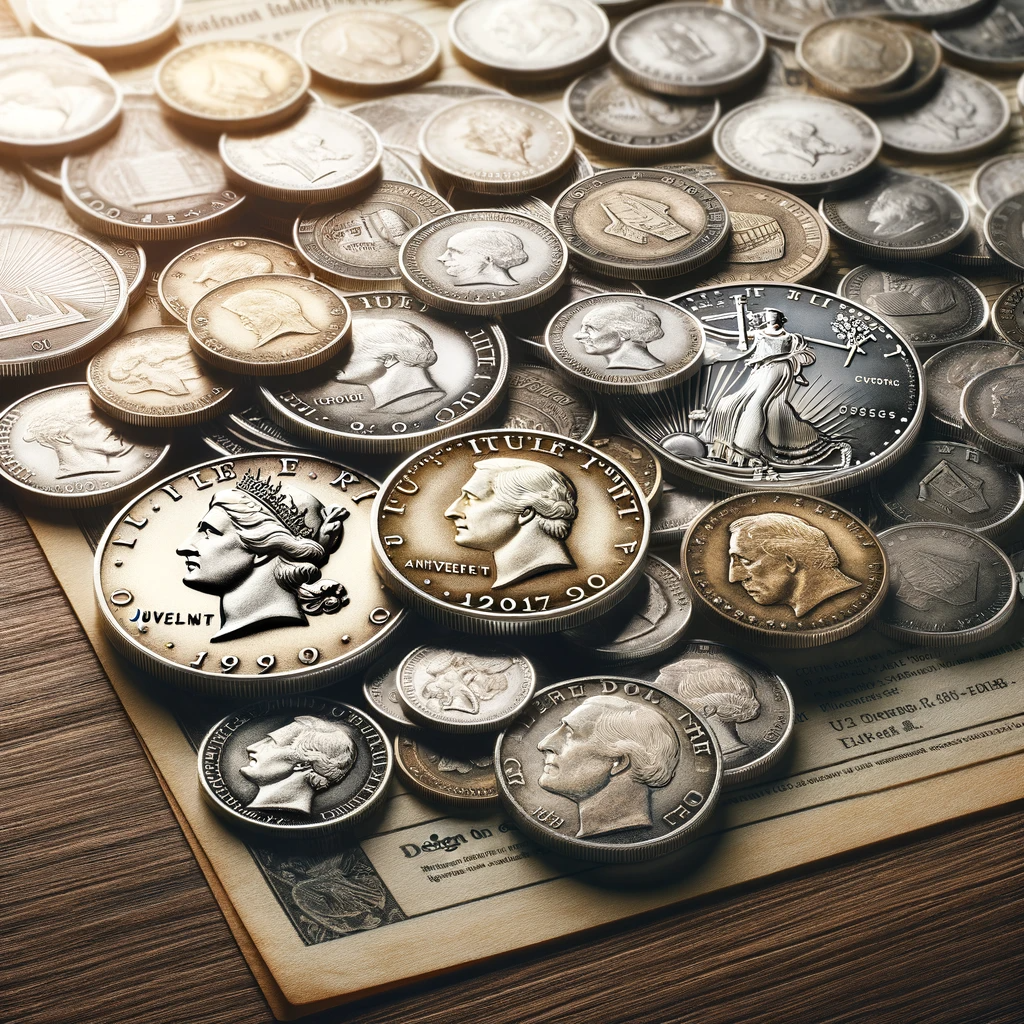
Junk silver primarily refers to a specific category of coins that were once everyday currency and now have limited investment and numismatic value. Their true worth lies in the scrap metal realm, often containing 90% or less pure silver content.
The term is also often used broadly to encompass various silver items that may have lower purity or are worn, damaged, or not in collectible condition. Sometimes referred to as Scrap Silver, this can include items like silverware, old jewellery, discarded dental fillings, or other silver objects that may not meet the standards for numismatic or investment-grade pieces. The key characteristic is the focus on the silver’s intrinsic metal value rather than its collectible or numismatic qualities.
Before the shift to modern coinage materials, coins were commonly minted with silver for added durability and value. Coins such as dimes, quarters, and half-dollars circulated widely, containing a notable percentage of silver. Over time, as economies evolved and currencies changed, these silver coins were gradually phased out of everyday use, giving rise to the term “junk silver.” Despite the shift, the intrinsic value of the silver within these coins persisted.
Junk silver typically falls into four main types – dimes, quarters, half-dollars, and silver dollars. These coins were minted before a pivotal moment in 1965 when the U.S. Mint reduced the silver content in circulating coins with the 1965 Coinage Act. Pre-1965 coins are often sought after for their silver value and historical significance.
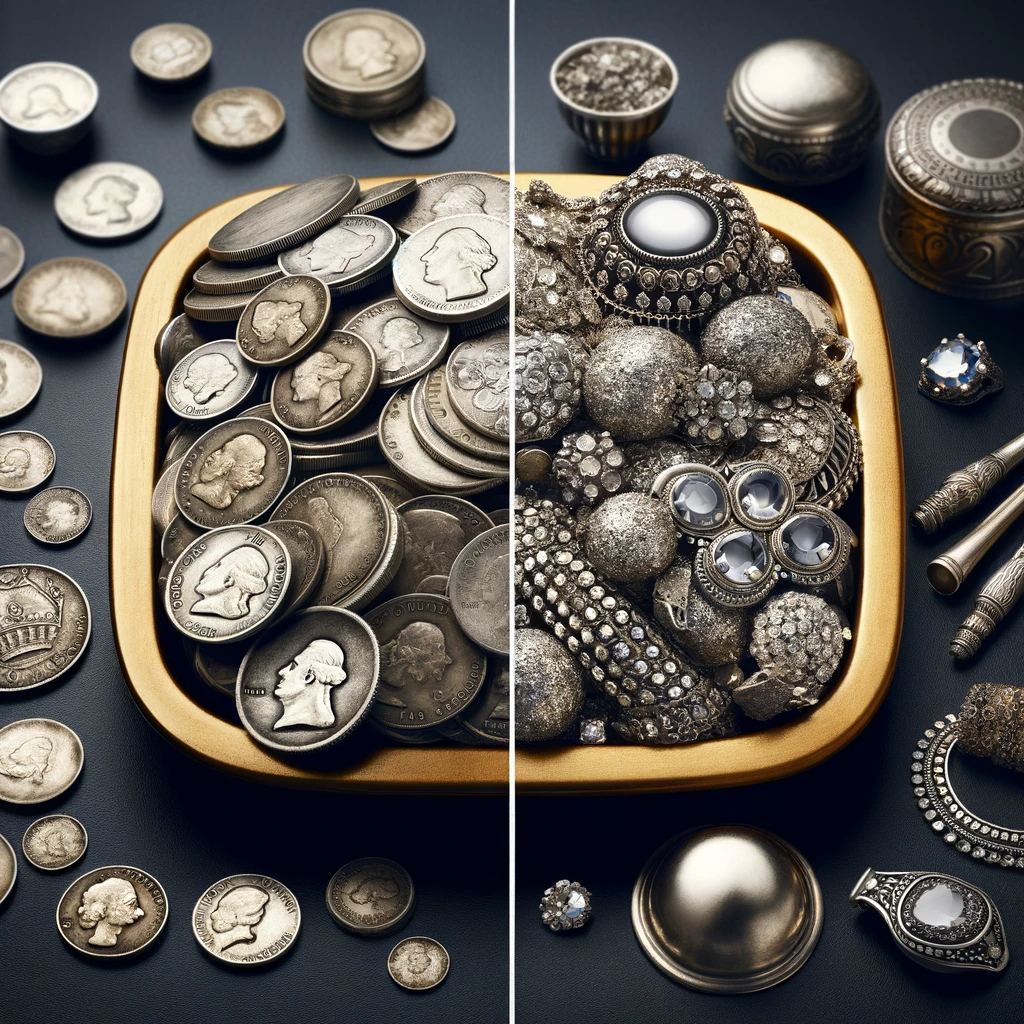
While the two terms can be casually interchanged, their real meanings have nuanced differences.
“Junk Silver” is more specific to certain coins with historical significance, while “Scrap Silver” encompasses a broader range of silver items that may not have any collectible or historical value. Both terms highlight the focus on the metal’s intrinsic value rather than the item’s aesthetic or numismatic qualities. Junk silver may fetch more value as it can be resold whereas scrap silver will likely be melted down which has an associated cost.
Understanding the various categories of junk silver coin not only sheds light on the historical significance of these coins but also forms the basis for evaluating their potential value. This isn’t an exhaustive list of junk silver coins but highlights the coins which compose a significant backbone to the market.
Definition: Junk silver dimes refer to coins with a face value of 10 cents that were minted before 1965.
Silver Content: Pre-1965 dimes commonly contain 90% silver, making them sought after by collectors for their intrinsic value.
Definition: Junk silver quarters have a face value of 25 cents and, like dimes, were minted before the pivotal year of 1965.
Silver Content: These quarters typically share the 90% silver composition, contributing to their appeal among those interested in silver stacking.
Definition: Junk silver half-dollars represent coins with a face value of 50 cents and were in circulation before the silver content reduction in 1965.
Silver Content: Similar to dimes and quarters, pre-1965 half-dollars contain around 90% silver, adding to their collectible value.
Definition: While less common in everyday transactions, junk silver dollars have a face value of one dollar and were minted with a notable silver content.
Silver Content: Though often containing slightly less silver (around 40%), silver dollars are still considered part of the junk silver category and attract collectors and investors.
Definition: War nickels, minted during World War II (1942-1945), are easily identified by a large mint mark above Monticello on the reverse.
Silver Content: These nickels contain 35% silver, offering a unique historical perspective within the realm of junk silver.
Definition: Canadian dimes, quarters, and half-dollars silver coins, especially those minted before 1967, when Canada halted silver coin production.
Silver Content: 80% purity, these Canadian coins contribute an international dimension to the diversity of junk silver.
Free ultimate guide for keen precious metals investors
The appeal of buying and selling junk silver lies in its practical value, affordability, and suitability for some investors and collectors. It offers an accessible and tangible way of gaining exposure to the silver market, while also offering a reminder of a bygone era when silver coins were used for everyday transactions. Some of the most common motivations for buying junk silver are as follows;
The primary draw of junk silver lies in its silver content. Pre-1965 coins, especially dimes, quarters, and half-dollars, often contain 90% silver or more. Investors and collectors are attracted to the tangible and intrinsic value of silver, making junk silver an accessible entry point into the world of precious metals.
Junk silver provides a cost-effective means for individuals to invest in silver. The coins, while no longer in circulation, offer a way to accumulate silver without the premium associated with newly minted bullion coins. This affordability makes junk silver an attractive option for those looking to diversify their investment portfolio with a tangible and historically rooted asset.
Beyond their silver content, junk silver coins carry historical significance. They bear the marks of an era when silver was a common component of everyday currency. Collectors appreciate the tangible connection to the past, as these coins reflect a time before the transition to modern coinage materials.
While not considered numismatic treasures, junk silver coins are collectible in their own right. Many individuals enjoy the thrill of assembling sets or accumulating coins from different historical periods. The broad range of denominations and types within the category adds a layer of diversity for collectors interested in building a varied and meaningful collection.
Junk silver is often favoured by those engaging in silver stacking – the practice of accumulating physical silver for its potential long-term value. The common denominations and recognizable types make it convenient for individuals to incrementally build their silver holdings over time.
Our automated portfolio builder will provide suggestions based on various investment objectives.
While owning junk silver presents a number of attractions, investing hard-earned cash into junk silver coins needs to be carefully considered. The niche offers a number of nuances over investment-grade silver coins and bars whose suitability may vary from investor to investor. Here are some investment considerations;
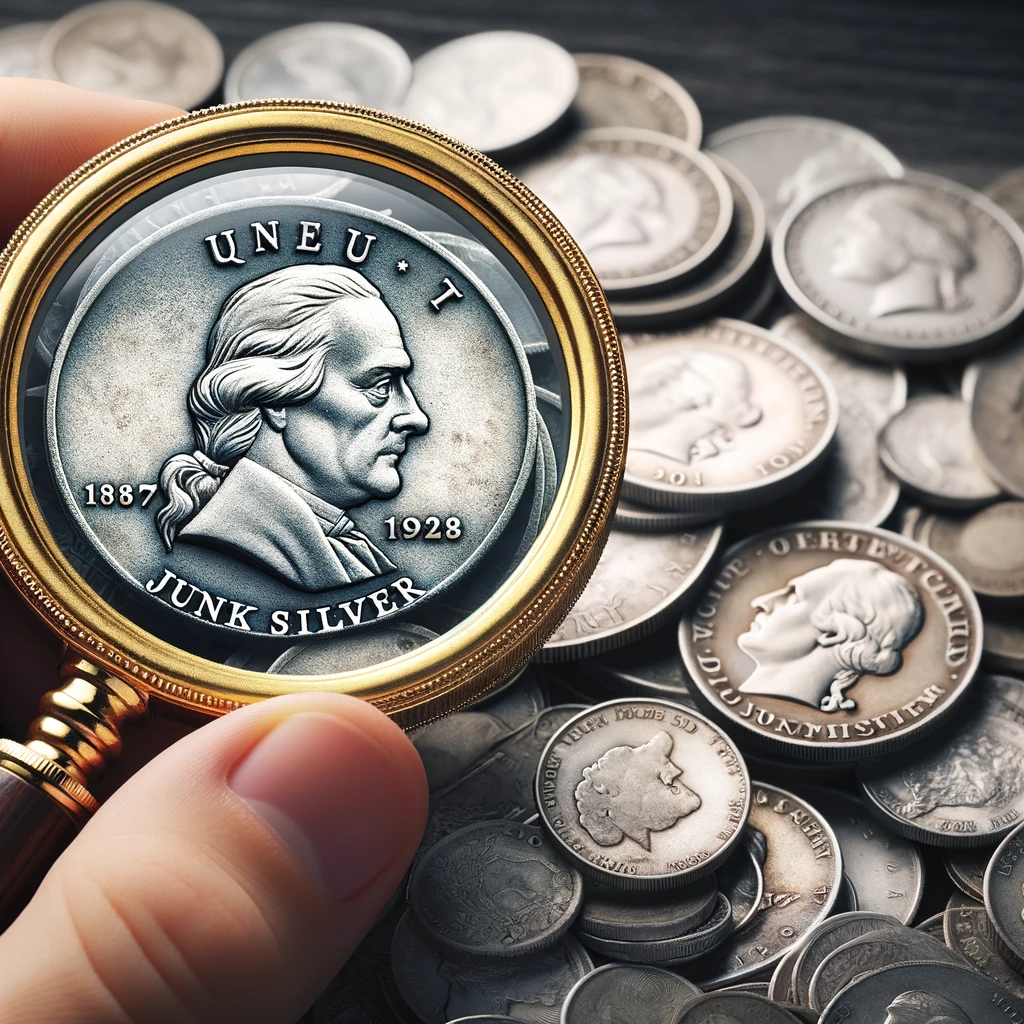
The variance in silver purity between different junk silver coins is vast. Unlike investing in investment-grade silver, silver content can differ considerably and represent very different propositions. While this inconsistent purity provides more choice and opportunity, it also creates more scope to overpay or buy illiquid coins.
Begin by deciding and grasping the silver content of the coins you’re interested in. Are you simply looking for the cheapest way to buy silver coins regardless of their purity, or do you need to stick to investment-grade silver coins?
Mint condition investment grade silver coins conform to a standardised and explicit specification. You never need to wonder how to sell these silver coins as liquidity is high, being well recognised with potential buyers knowing what they’re getting.
In the realm of junk silver coins, the possible disparity of conditions and precious metals content may create more friction when selling. The speed in which coins can be sold may be less fluid and prices more negotiable than selling more recent higher purity silver coins.
The main appeal of buying junk silver coins is their relative low cost. Premiums are generally far lower on these coins than brand new bullion silver coins. The lower cost is reflective of their condition, lower purity and possible desire for dealers to sell less conventional stock.
Understanding the correct value when buying, holding and selling the junk silver coins can be less ambiguous than investment grade silver coins. Prices of typical junk coins should reflect their silver content far more closely than newer bullion coins where dealers may command inflated premiums if coins are deemed to be more desirable. Silver coins which combine high purity with rarity tend to be the silver coins worth the most.
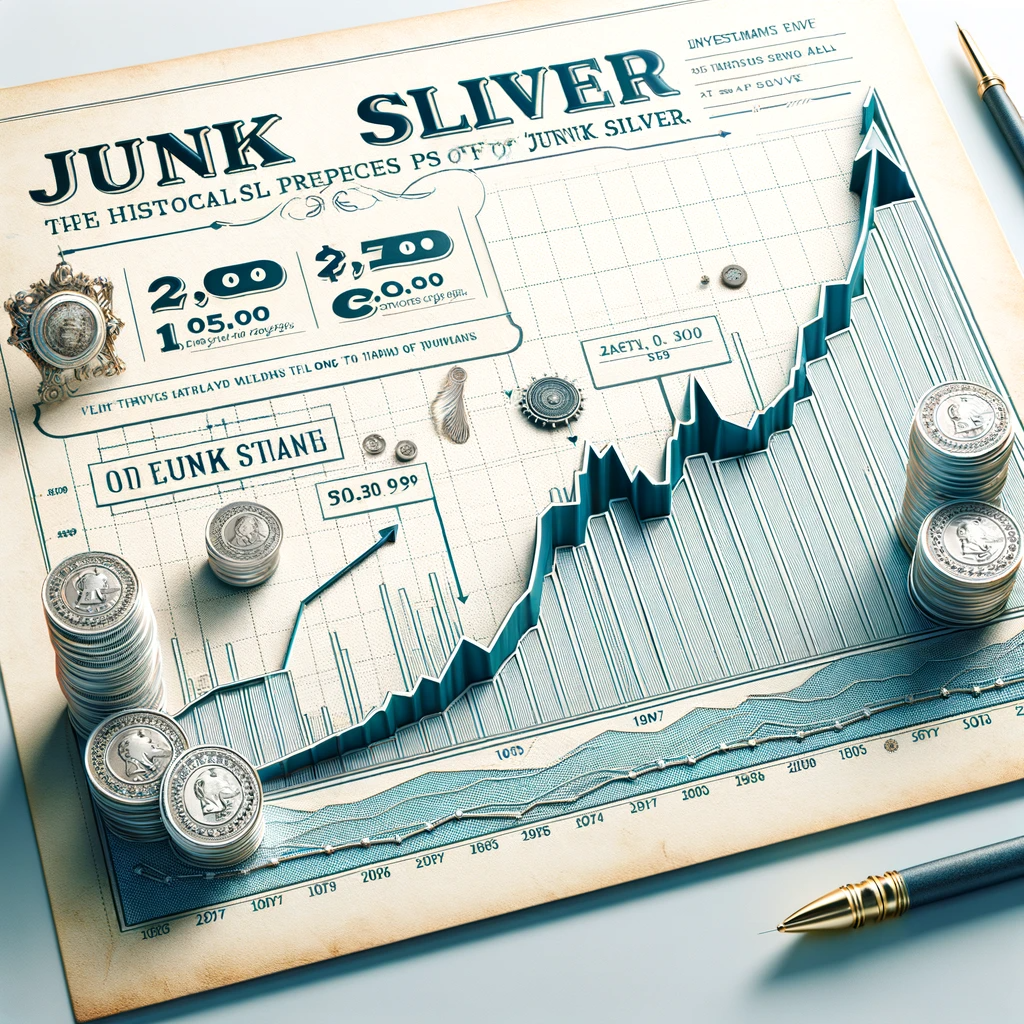
Profit potential on junk silver coins vs higher purity silver depends on a number of factors. Profit could be enhanced by the fact that purchase premiums can be far lower than that of high-grade silver coins. This is particularly relevant if holding the silver for a shorter period of time.
However, the value of junk silver coins will only ever track the movement in the silver price so timing is crucial to make a return after deducting bid/offer spreads. Investment grade silver coins can increase in value at a higher rate than just the underlying silver spot price. This possible enhanced upside potential can be due to numismatic value attributed to their rarity, collectability and market demand. But to overcome the larger initial premium paid, this tends to suit longer term investing.
If you are able to buy and sell silver coins at a profit, then taxation in your jurisdiction is another important investment consideration. In the UK, buying and selling silver Britannias at a profit benefits from being exempt from Capital Gains tax (CGT) due to the Britannia’s status as legal tender. If you’re anticipating substantial profits, selling junk coins from overseas would be liable to taxation, impacting your profit.
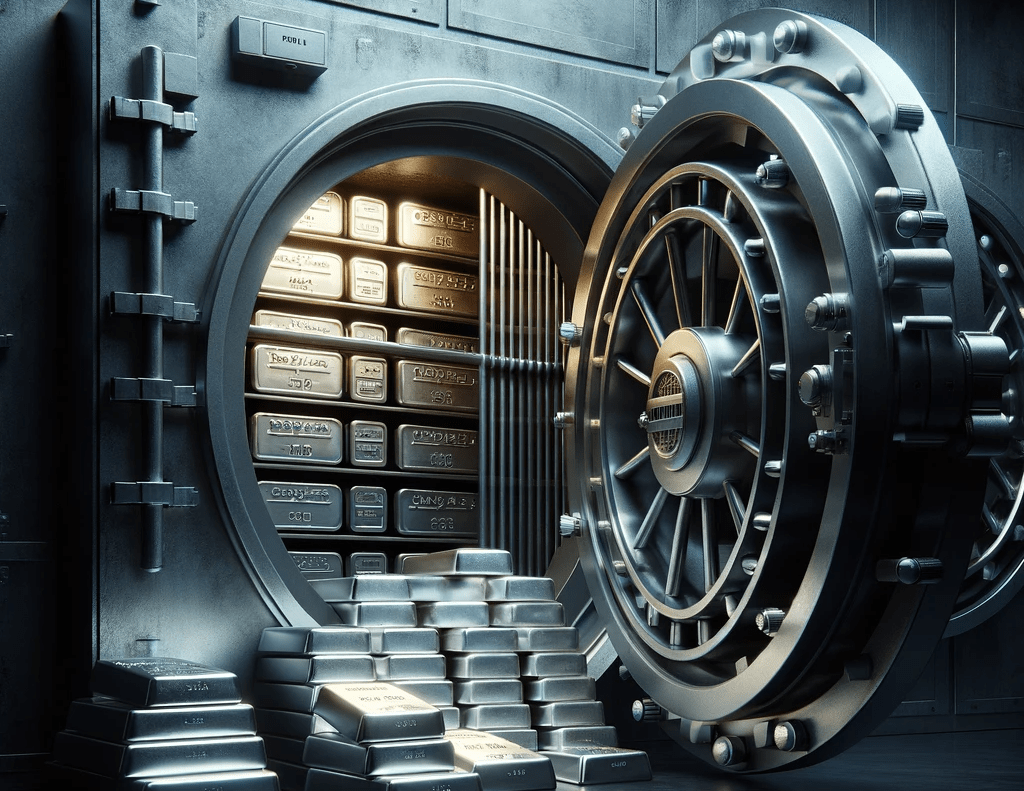
When it comes to storing your junk silver coins, practical considerations play a crucial role in safeguarding your investment. The reduced cost of junk silver coins means that you’ll be able to buy a greater volume of silver for your budget than investing in higher purity silver coins. But with that enhanced volume, comes increased storage requirements.
Small amounts can be stored in a home safe, but larger quantities may need to be kept in professional vaults which will have a cost associated to cover storage and insurance. This inflated cost needs to be factored into investment decisions. Proper storage not only ensures the physical integrity of your investment but also helps maintain the condition of the coins over time.
Incorporating junk silver into your investment portfolio is a practical strategy for diversification. By balancing your investments across various asset classes, including precious metals like junk silver, you can mitigate risks and enhance overall financial stability. Diversification provides a well-rounded approach to wealth preservation, ensuring that your investment portfolio is not overly reliant on a single asset class.
Junk silver’s tangible value make it a valuable component in a diversified portfolio, which can contribute to a comprehensive and resilient investment strategy. Moreover, adding junk silver to an existing investment grade silver holding, can help to balance out your precious metals holding.
Identifying various junk silver coins is a practical skill for those seeking to participate in trading the low-cost coins. With so much variety within the world of junk silver coins, it’s crucial to know which elements to look out for.
Examine the coin’s date of minting. Junk silver coins in the United States were typically minted before 1965. This pre-1965 period is crucial, as it signifies a time when these coins commonly contained 90% silver.
Recognize common denominations. Dimes, quarters, and half-dollars are prevalent in the world of junk silver. Understanding the specific denominations aids in quick identification.
Look for silver content markings. Often denoted as a percentage (e.g., 90% silver), this indicates the purity of the coin. Pre-1965 U.S. coins commonly have a 90% silver content.
Familiarize yourself with the distinctive appearance of junk silver coins. While wear and tear may be present, the recognizable designs and historical features endure, aiding in their identification.
Use a magnet for verification. Junk silver coins, being predominantly silver, are non-magnetic. If a coin is attracted to the magnet, it may contain a significant amount of base metal and not qualify as junk silver.
Consider weighing the coins. Authentic junk silver coins should have a weight consistent with their known silver content. Deviations in weight could signal issues with the coin’s authenticity.
Engage in research. Familiarize yourself with the specific characteristics of junk silver coins through reputable sources. If uncertain, seek guidance from knowledgeable dealers or numismatists to ensure accurate recognition.
Sterling silver, typically composed of 92.5% silver and 7.5% alloy (usually copper), is not classified as junk silver. The term “junk silver” typically refers to certain U.S. coins with a higher silver content minted before 1965. Sterling silver, while valuable and commonly used in jewellery and silverware, falls outside this specific category.
The primary distinction lies in the silver content; junk silver coins often have a silver content of 90% or more, making them desirable for precious metal investment. Sterling silver, although valuable for its aesthetic and practical purposes, doesn’t meet the same criteria.
Investors and collectors should recognize that the term “junk silver” is specific to certain denominations and periods in U.S. coinage history. Sterling silver, with its different composition and applications, doesn’t align with the characteristics of junk silver coins. If considering precious metal investment, understanding these distinctions ensures clarity in choosing the right type of silver for one’s financial objectives.
Junk silver provides a highly cost-effective method of accumulating silver. Premiums are considerably lower than higher fineness coins. However, we still recommend that serious silver coin investors stick with investment grade silver, or at least combine the two niches. High purity coins may cost more per gram, but they can increase in value depending on their numismatic appeal, are highly liquid and can offer a tax efficient return.
Call our expert team on 020 7060 9992 or email info@physicalgold.com
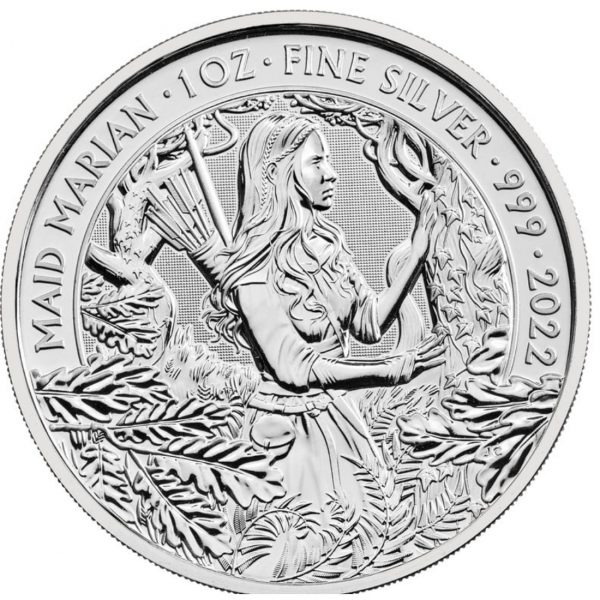
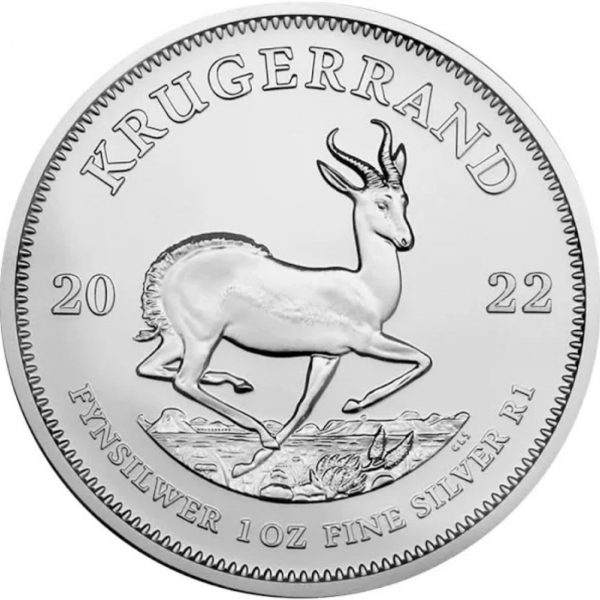
To identify junk silver coins, look for U.S. dimes, quarters, and half dollars minted before 1965. These coins contain 90% silver, making them valuable for their precious metal content rather than their collectible or numismatic worth.
Junk silver coins earned their name as they are circulated 90% U.S. silver coins, minted before 1965, lacking significant collectible or numismatic value. The term ‘junk’ reflects their primary value being derived from their silver content rather than rarity or collector’s appeal.
Junk silver stands apart from other silver coins by emphasizing its intrinsic metal value over collectibility. Commonly referring to pre-1965 U.S. coins, it prioritizes silver content rather than numismatic worth, making it distinct from coins valued for rarity or collector’s appeal.
Junk silver, comprising older coins with high silver content, presents a practical investment. Valued for the intrinsic metal composition rather than collector’s worth, it offers a tangible and accessible entry to precious metals investment.
90% silver coins, often called Junk Silver or US 90% Silver Coins, are old U.S. currency coins valued for their 90% silver content. Mainly minted pre-1965, including half dollars, quarters, and dimes, these coins hold intrinsic worth based on their silver bullion content.
To sell junk silver coins, follow these steps: 1. Verify authenticity and silver content. 2. Research current market prices. 3. Choose a reputable buyer or dealer. 4. Consider transaction costs. 5. Ensure compliance with legal and tax regulations in your jurisdiction. Selling through trusted sources and staying informed ensures a secure and transparent transaction.
Live Gold Spot Price in Sterling. Gold is one of the densest of all metals. It is a good conductor of heat and electricity. It is also soft and the most malleable and ductile of the elements; an ounce (31.1 grams; gold is weighed in troy ounces) can be beaten out to 187 square feet (about 17 square metres) in extremely thin sheets called gold leaf.
Live Silver Spot Price in Sterling. Silver (Ag), chemical element, a white lustrous metal valued for its decorative beauty and electrical conductivity. Silver is located in Group 11 (Ib) and Period 5 of the periodic table, between copper (Period 4) and gold (Period 6), and its physical and chemical properties are intermediate between those two metals.